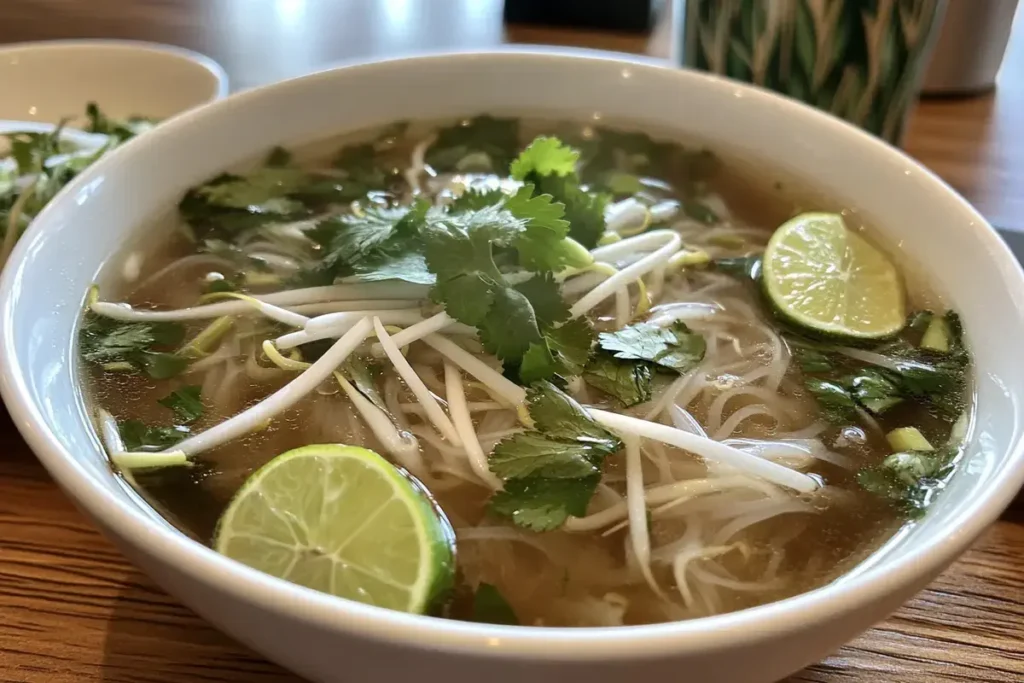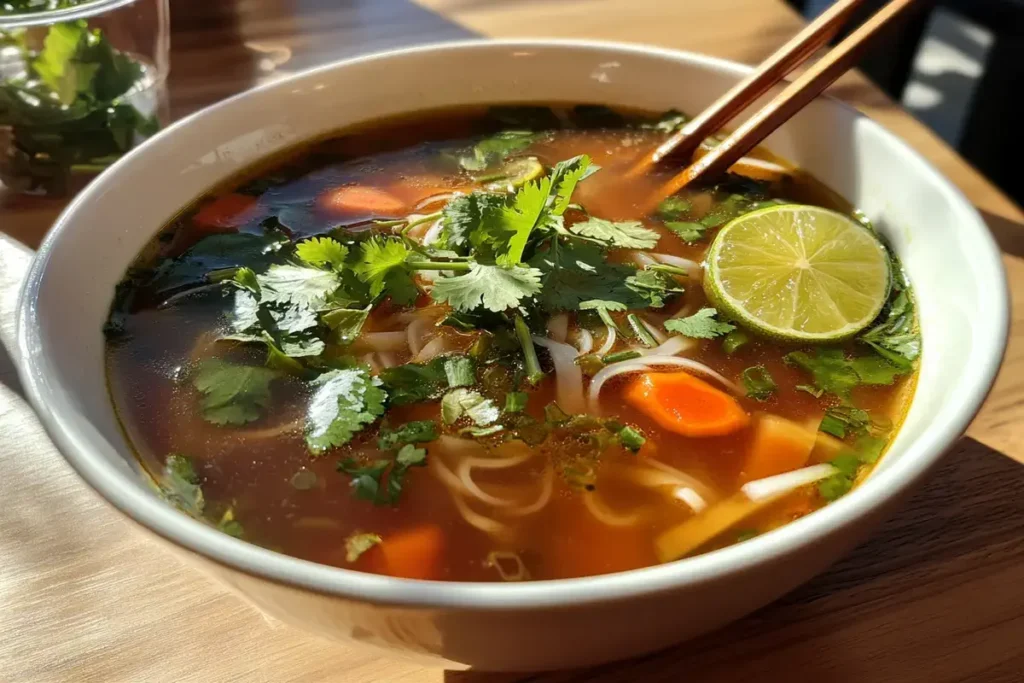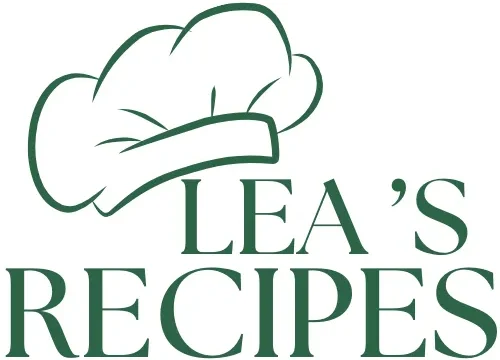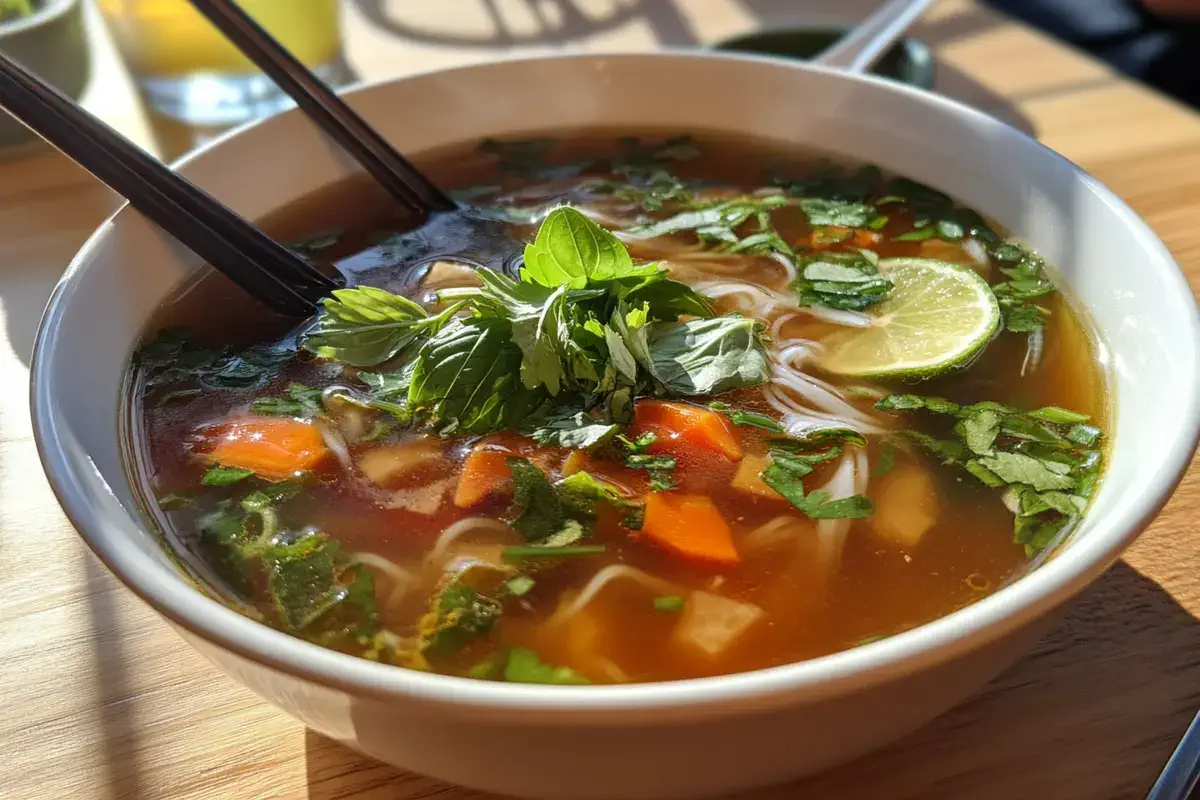The famous soup in Vietnam is not just a meal; it is a cultural treasure that represents the heart of Vietnamese cuisine. Renowned for its fresh ingredients, aromatic broths, and vibrant flavors, these soups have become iconic worldwide. Dishes like Phở, Bún Bò Huế, and Canh Chua are celebrated not only for their taste but also for their connection to Vietnam’s history and regional diversity.
Moreover, soup holds a deep cultural significance in Vietnam, symbolizing warmth, comfort, and togetherness. Whether enjoyed at bustling street markets or quiet family dinners, each bowl reflects the culinary traditions of its region. For instance, northern soups focus on simplicity, while central dishes embrace bold spices, and southern variations highlight tangy and sweet flavors.
Ultimately, exploring the famous soup in Vietnam offers a delicious journey through the country’s rich culinary identity, where each bite reveals a harmonious blend of tradition and flavor.
The Cultural Importance of Famous Soup in Vietnam
Vietnamese cuisine is synonymous with harmony, tradition, and flavor, and its soups are a centerpiece of this culinary identity. The art of crafting these soups has been passed down for generations, making them not just meals but cultural treasures. Each bowl tells a story of Vietnam’s rich history, regional diversity, and dedication to fresh ingredients.
Why Soups Hold a Special Place in Vietnamese Culture
In Vietnam, soup isn’t just food; it’s a way of life. From bustling markets to quiet family dinners, soups are enjoyed across all social and economic classes. They symbolize warmth, hospitality, and the spirit of togetherness. Among the most iconic examples of this is the globally celebrated Phở, a dish so intertwined with Vietnamese culture that it’s often the first introduction to the nation’s cuisine for foreigners.
A Diverse Culinary Landscape
Vietnam’s regional diversity plays a critical role in shaping its soups.
- In the north, you’ll find delicate, clear broths that reflect the simplicity of Hanoi’s culinary tradition.
- Central Vietnam, with its spicier palate, boasts bold dishes like Bún Bò Huế.
- The south brings sweet and tangy profiles, epitomized by Canh Chua.
The Essentials of Famous Soup in Vietnam
Freshness is Key
The defining characteristic of all famous soup in Vietnam is the use of fresh, locally sourced ingredients.
- Herbs such as basil, cilantro, and scallions are integral.
- Proteins range from tender beef and chicken to seafood like crab and fish.
- Broths are crafted with care, often simmered for hours to extract maximum flavor.
The Role of Soup in Daily Life
In Vietnam, soup isn’t confined to dinner tables. It’s a versatile meal consumed at any time of day. Here’s how soups fit into daily Vietnamese routines:
- Breakfast: Bowls of Phở are a common morning sight, providing a hearty, warming start to the day.
- Lunch and Dinner: Dishes like Bún Thang or Bún Riêu serve as satisfying meals.
- Street Food Culture: Vendors lining the streets offer steaming soups, filling the air with irresistible aromas.
An Iconic Representation: Phở
No discussion of famous soup in Vietnam is complete without highlighting Phở. It’s more than a dish; it’s a cultural ambassador. Originating in the early 20th century, Phở has become a staple in Vietnamese households and restaurants worldwide. The dish is loved for its:
- Rich, flavorful broth
- Tender slices of beef or chicken
- Fresh garnishes like lime, bean sprouts, and Thai basil
The beauty of Phở lies in its balance—it’s simultaneously hearty and light, complex yet approachable. Whether you’re enjoying a bowl at a street stall or a high-end eatery, the experience is consistently heartwarming.
Regional Variations of Soup in Vietnam
Vietnam’s geography contributes to the diversity of its soups:
- Northern Variants: Highlight simplicity and clarity. Phở Bắc, for example, is known for its clean, savory broth.
- Central Spices: Soups like Bún Bò Huế showcase the region’s love for bold, spicy flavors.
- Southern Sweetness: Canh Chua reflects the south’s preference for sweet and tangy profiles, often incorporating tamarind and pineapple.
Exploring the Famous Soup in Vietnam: Regional Highlights and Signature Dishes

Vietnam’s soups are more than culinary masterpieces—they’re a reflection of the country’s geography, culture, and history. Each region of Vietnam has contributed its own unique flavors to create a diverse palette of dishes that delight locals and visitors alike.
Northern Vietnam: The Birthplace of Simplicity
Phở Bắc: The Original Famous Soup in Vietnam
The northern regions, particularly Hanoi, are known for their minimalist approach to soup, with an emphasis on clear broths and unadulterated flavors. Phở Bắc is the quintessential example. This version of Phở features:
- A clear, savory broth made by simmering beef bones for hours.
- Simple garnishes such as scallions, cilantro, and slices of beef or chicken.
- A focus on balance, without overpowering spices.
The delicate yet rich flavors of Phở Bắc make it a cornerstone of Vietnamese culinary tradition. Learn more about its prominence and the delicate art of crafting this dish from resources like the guide to Vietnamese soups.
Bún Thang: Hanoi’s Culinary Gem
Another northern delicacy, Bún Thang, is a visually stunning soup that’s as complex in preparation as it is in flavor. Known for its light chicken broth, Bún Thang is garnished with:
- Thinly sliced omelet strips.
- Shredded chicken and pork.
- Herbs like Vietnamese coriander and spring onions.
This dish often graces festive occasions and gatherings in Hanoi, symbolizing warmth and hospitality.
Central Vietnam: Bold Flavors and Spices
Bún Bò Huế: Spicy and Robust
Central Vietnam is famed for its love of spice, and Bún Bò Huế is a prime example of this boldness. Originating from the ancient city of Huế, this soup combines spicy, umami-rich flavors with thick noodles. Key characteristics include:
- A fiery red broth flavored with lemongrass, shrimp paste, and chili oil.
- Generous portions of beef, pork, and sometimes even blood sausage.
- An aromatic garnish of lime, chili slices, and fresh herbs.
Mì Quảng: A Unique Take on Soupy Noodles
Although not a traditional soup, Mì Quảng deserves mention for its hybrid style. This dish features:
- Turmeric-tinted rice noodles.
- A scant, concentrated broth often made with pork, shrimp, or chicken.
- A topping of crushed peanuts, fresh herbs, and sesame crackers.
Hailing from Quảng Nam province, Mì Quảng showcases the region’s ingenuity and creativity.
Southern Vietnam: Sweet and Tangy Flavors
Canh Chua: A Flavorful Symphony
The southern regions embrace sweet and tangy profiles, as seen in Canh Chua. This soup is a celebration of the Mekong Delta’s bounty, incorporating:
- Fresh fish, often catfish, as the primary protein.
- Tamarind for its tangy base and pineapple for a touch of sweetness.
- Vegetables like okra, bean sprouts, and tomatoes.
Bún Riêu: Crab-Infused Goodness
Another southern favorite, Bún Riêu offers a distinctive twist with its crab-based broth. It’s beloved for its:
- Rich tomato and crab paste base.
- Additional toppings such as tofu, minced crab meat, and vermicelli noodles.
- A garnish of herbs, lime, and chili paste.
This dish is a vibrant addition to the array of famous soup in Vietnam, showcasing the resourcefulness of southern cooks in utilizing local seafood.
National Favorites: Soups Beyond Geography
Bánh Canh: The Hearty Option
With its thick tapioca or rice noodles, Bánh Canh stands out for its hearty, chewy texture. This versatile dish can be found nationwide, with popular variations including:
- Bánh Canh Cua (crab soup).
- Bánh Canh Chả Cá (fish cake soup).
- Bánh Canh Tôm (shrimp soup).
The dish’s adaptability makes it a beloved staple in both home kitchens and street vendors.
Sweet Soups: Vietnam’s Unique Dessert Soups
Vietnamese soups aren’t limited to savory options. Sweet soups, such as Chè and Vegan Vietnamese Sweet Soup, offer a delightful end to any meal. These soups often feature:
- Coconut milk, mung beans, or tapioca pearls.
- A variety of fruits and nuts for added texture.
If you’re looking to explore plant-based dessert soups, see vegan Vietnamese sweet soup for a unique experience.
The Role of Street Food in Preserving Famous Soup in Vietnam
Vietnam’s vibrant street food culture has undeniably played a pivotal role in popularizing its soups. From early morning to late night, street vendors across the country consistently serve up bowls of steaming Phở, Bún Riêu, and Canh Chua. Furthermore, these stalls are not just eateries—they’re also community hubs where people gather, share stories, and relish the simple pleasure of a hot, flavorful meal.
In addition to providing delicious food, street vendors help preserve traditional recipes by relying on age-old techniques passed down through generations. Consequently, this connection to heritage ensures that the flavors remain authentic and true to their origins. Ultimately, the experience of savoring a bowl of famous soup in Vietnam at a street stall offers an unforgettable cultural immersion, blending tradition, community, and culinary artistry.
Frequently Asked Questions About Famous Soup in Vietnam

Vietnamese soups are an integral part of the country’s rich culinary tapestry, and many people have questions about these iconic dishes. This section explores some common inquiries to provide deeper insights into the world of famous soup in Vietnam.
The iconic Vietnamese soup is Phở. Known for its aromatic broth, tender meat, and silky noodles, it’s a cultural symbol and a global favorite. Its name, derived from the French word “feu” (fire), reflects its colonial origins.
While Phở holds the spotlight, other noodle-based soups like Bún Bò Huế and Bánh Canh are equally beloved. Bún Bò Huế is cherished for its spicy, rich broth and thick noodles, while Bánh Canh stands out for its hearty, chewy tapioca or rice noodles.
Both soups reflect the diversity of famous soup in Vietnam, showcasing how regional flavors influence preparation.
In Vietnam, street food culture thrives with soups like Phở, Bún Riêu, and Canh Chua taking center stage. Freshly prepared at makeshift stalls, these dishes are enjoyed on low stools amidst the lively buzz of Vietnamese streets. Vendors are praised for their:
Authentic, traditional recipes.
Fresh, local ingredients.
Affordable prices, ensuring accessibility.
Undoubtedly, Phở is the most famous dish in Vietnam. Its delicate balance of flavors has made it a favorite not just within Vietnam but also globally. However, dishes like Bún Bò Huế and Canh Chua have also gained international recognition, thanks to their bold, distinctive flavors.
Exploring the Ingredients That Define Famous Soup in Vietnam

Vietnamese soups are a celebration of fresh, wholesome ingredients. The foundation of each soup is its broth, which is often simmered for hours to achieve a depth of flavor. Other essential components include:
- Proteins: Beef, chicken, fish, pork, or seafood.
- Noodles: Varieties like rice noodles, vermicelli, or tapioca-based noodles.
- Herbs and Garnishes: Thai basil, cilantro, scallions, bean sprouts, and lime.
- Flavor Enhancers: Fish sauce, tamarind, lemongrass, and chili oil.
This meticulous attention to ingredients makes every bowl of famous soup in Vietnam a masterpiece.
Vegetarian and Vegan Options
For those with dietary restrictions, Vietnam offers plenty of vegetarian and vegan versions of its soups. These alternatives retain the authentic flavors while substituting meat with tofu, mushrooms, or plant-based broths. A great example is vegan Vietnamese sweet soup, which highlights the country’s ability to innovate without compromising tradition.
The Global Appeal of Vietnamese Soups
The famous soup in Vietnam has transcended borders, appearing on menus worldwide. Its international popularity can be attributed to:
- Health Benefits: Most Vietnamese soups are low in fat and packed with fresh ingredients.
- Versatility: The variety of flavors, from mild to spicy, ensures there’s something for everyone.
- Ease of Preparation: While authentic recipes require time, simplified versions make it accessible to home cooks.
The spread of Vietnamese restaurants across major cities has brought dishes like Phở and Bún Bò Huế to a global audience, cementing their status as culinary icons.
Conclusion: A Bowl of Vietnam in Every Sip
From its bustling street food stalls to fine dining establishments, Vietnam’s soups offer a rich culinary experience that captures the essence of the nation’s culture. Whether it’s the globally adored Phở, the fiery Bún Bò Huế, or the tangy Canh Chua, each bowl represents a unique story of flavor, tradition, and innovation. For those looking to explore these delights further, Vietnam’s soups promise an unforgettable journey into the heart of its culinary heritage.

